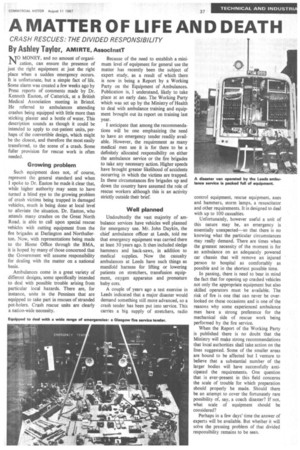A MATTER OF LIFE AND DEATH
Page 39

If you've noticed an error in this article please click here to report it so we can fix it.
CRASH RESCUES: THE DIVIDED RESPONSIBILITY By Ashley Taylor, AM I RTE, AssocInstT NO MONEY, and no amount of organization, can ensure the presence of just the right equipment at just the right place when a sudden emergency occurs. It is unfortunate, but a simple fact of life. Some alarm was created a few weeks ago by Press reports of comments made by Dr. Kenneth Easton, of Catterick, at a British Medical Association meeting in Bristol. He referred to ambulances attending crashes being equipped with little more than sticking plaster and a bottle of water. This description sounds as though it could be intended to apply to out-patient units, perhaps of the convertible design, which might be the closest, and therefore the most easily transferred, to the scene of a crash. Some fuller provision for rescue work is often needed.
Growing problem
Such equipment does not, of course, represent the general standard and when I spoke to Dr. Easton he made it clear that, while higher authority may seem to have turned a blind eye to the growing problem of crash victims being trapped in damaged vehicles, much is being done at local level to alleviate the situation. Dr. Easton, who attends many crashes on the Great North Road, is able to call upon special rescue vehicles with cutting equipment from the fire brigades at Darlington and Northallerton. Now, with representations being made to the Home Office through the BMA, it is hoped by many of those concerned that the Government will assume responsibility for dealing with the matter on a national basis.
Ambulances come in a great variety of different designs, some specifically intended to deal with possible trouble arising from particular local hazards. There are, for instance, units in the Pennines that are equipped to take part in rescues of stranded pot-holers. Crash rescue units are clearly a nation-wide necessity. Because of the need to establish a minimum level of equipment for general use the matter has recently been the subject of expert study, as a result of which there is now in being a Report by a Working Party on the Equipment of Ambulances. Publication is, I understand, likely to take place at an early date. The Working Party which was set up by the Ministry of Health to deal with ambulance training and equipment brought out its report on training last year.
I anticipate that among the recommendations will be one emphasizing the need to have an emergency tender readily available. However, the requirement as many medical men see it is for there to be a definitely allocated responsibility on either the ambulance service or the fire brigades to take any necessary action. Higher speeds have brought greater likelihood of accidents occurring in which the victims are trapped. In these circumstances fire brigades up and down the country have assumed the role of rescue workers although this is an activity strictly outside their brief.
Well planned
Undoubtedly the vast majority of ambulance services have vehicles well planned for emergency use. Mr. John Daykin, the chief ambulance officer at Leeds, told me that emergency equipment was carried there at least 30 years ago. It then included sledge hammers and hack-saws, in addition to medical supplies. Now the casualty ambulances at Leeds have such things as manifold harness for lifting or lowering patients on stretchers, transfusion equipment, oxygen apparatus and premature baby cots.
A couple of years ago a test exercise in Leeds indicated that a major disaster would demand something still more advanced, so a crash tender has been put into service. This carries a big supply of stretchers, radio control equipment, rescue equipment, axes and hammers, storm lamps, a resuscitator and other requirements. It is designed to deal with up to 100 casualties.
Unfortunately, however useful a unit of this nature may be, an emergency is essentially unexpected—so that there is no knowing what the particular circumstances may really demand. There are times when the greatest necessity of the moment is for an ambulance on an adequately powered car chassis that will remove an injured person to hospital as comfortably as possible and in the shortest possible time.
In passing, there is need to bear in mind the fact that for opening up crashed vehicles not only the appropriate equipment but also skilled operators must be available. The risk of fire is one that can never be overlooked on these occasions and is one of the reasons why some experienced ambulance men have a strong preference for the mechanical side of rescue work being performed by the fire service.
When the Report of the Working Party is published there is no doubt that the Ministry will make strong recommendations that local authorities shall take action on the lines suggested. Some of the smaller areas are bound to be affected but I venture to believe that a substantial number of the larger bodies will have successfully anticipated the requirements. One question that is ever-present in this field concerns the scale of trouble for which preparation should properly be made. Should there be an attempt to cover the fortunately rare possibility of, say, a coach disaster? If not, what scale of equipment should be considered?
Perhaps in a few days' time the answer of experts will be available. But whether it will solve the pressing problem of that divided responsibility remains to be seen.












































































































